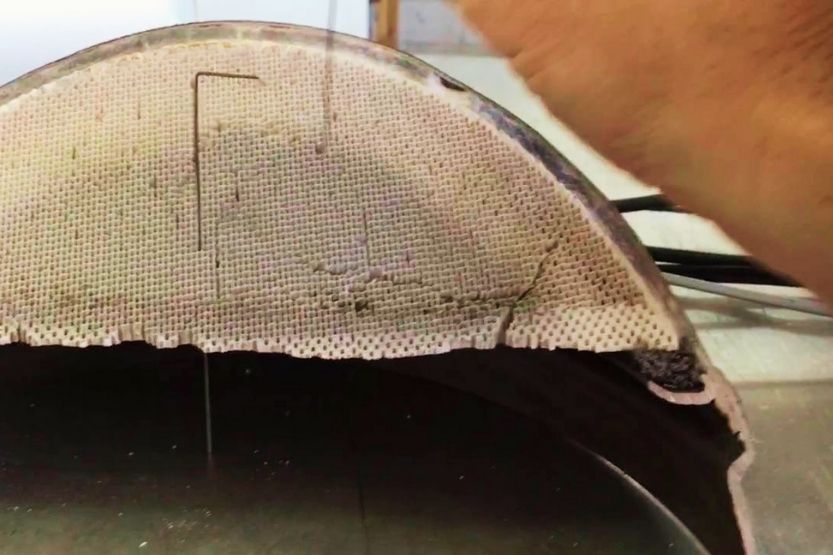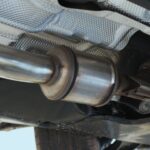An adequately maintained catalytic converter increases your car’s efficiency, directly impacting its overall health and performance. One of a car’s essential components is a catalytic converter since it helps minimize emissions into less harmful gases that could affect people and the environment. But what happens if your car’s catalytic converter goes bad?
A catalytic converter is located between the engine and the exhaust’s muffler. Driving with a bad catalytic converter will result in higher emissions. Your vehicle might not pass an inspection, and you can’t drive legally.
Continue reading to learn how a bad catalytic converter can affect your car’s performance and what you can do to fix it.
What Happens When a Catalytic Converter Goes Bad?

A contaminated, clogged, overheated, or physically damaged catalytic converter will result in the following:
- Sluggish engine performance,
- Reduced speed,
- Engine shutdown, and
- Difficulty managing pressure buildup.
What Is a Catalytic Converter and What Does It Do?
1. Reduces Harmful Gases Being Released into the Atmosphere
You can find catalytic converters installed in the exhaust system of cars. Converters reduce nitrogen oxides, carbon monoxide, and hydrocarbons released into the atmosphere.
Catalytic converters minimize these harmful substances by 90% before releasing them through the exhaust pipes. A catalytic converter’s job is to convert toxic pollutants into less harmful emissions before they exit a car’s exhaust system.
2. Improves Car Efficiency
The catalytic converter’s primary function is to filter out hazardous by-products in the exhaust and burn them up.
Plus, it improves your car’s efficiency. If you regularly maintain your car, you can extend the life of your catalytic converter, reducing the likelihood of a costly catalytic converter repair or replacement.
3. Act as Mufflers
Catalytic converters reduce hazardous emissions and act as mufflers, making the engine sound quieter.
Two Types of Catalytic Converters
The catalytic converter has two types:
- Reduction Catalyst: Removes the nitrogen oxides, which does so by breaking down the nitrogen atoms from the compound, resulting in harmless nitrogen and oxygen gases.
- Oxidation Catalyst: Oxidizes carbon monoxide and converts it into carbon dioxide.
Reduction and oxidation catalysts have ceramic structures covered with a metal catalyst such as platinum, rhodium, or palladium arranged in a honeycomb pattern.
Catalytic converters have the disadvantage of only working at high temperatures and taking 10 to 15 minutes to warm up properly. It won’t work the first few minutes after you start your car.
What Are the Signs of a Clogged Catalytic Converter?

According to automobile experts, a catalytic converter can operate for up to ten years under normal use. Nonetheless, as the catalytic converter ages, it can tear, wear, clog, and become damaged, needing the installation of a new one.
Here are the signs that a catalytic converter is going bad:
1. Stalling Engine
The engine’s performance will begin to deteriorate and continue to deteriorate over time. If your car’s catalytic converter is bad, you will notice an evident distinction between stepping on the car’s accelerator and being accelerated.
The exhaust system cannot convert harmful gases into less toxic pollutants for discharge. As a result, these gases will build up in the engine, producing high pressure, causing the engine to stall and be difficult to start.
2. Exhaust Produces a Rattling Sound
Any strange noises from your vehicle could signal a problem with internal components. This is frequently the result of some loose parts in your catalytic converter causing the noise.
The loose components could eventually block your entire exhaust pipe and stop your wheels. Hence, if you begin to hear anything unusual, you should take your car to an experienced mechanic to repair or replace those parts.
3. Lower Fuel Efficiency
While numerous variables might cause a reduction in fuel efficiency, one of them could be a faulty catalytic converter. The engine will not receive oxygen if the catalytic converter goes bad.
As a result, the engine will consume more fuel, resulting in decreased fuel efficiency. Then you will have to replenish the fuel tank considerably more frequently.
4. Check Engine Light Is On
When this is on, this means there is something wrong with the car’s engine computer. If the light starts flashing, it means there is a severe problem, such as a misfire, which can quickly overheat the catalytic converter.
The air-to-fuel ratio will be changed if the catalytic converter fails, resulting in a large output of hazardous pollutants.
5. Rotten Egg Odor
Aside from the engine light, the smell of rotten eggs is the easiest sign to detect a failed catalytic converter.
As mentioned above, the catalytic converter turns exhaust gases into less toxic pollutants. However, if it becomes clogged, the exhaust system will build up unburned fuel. The fuel has a sulfate substance that usually smells like a rotten egg.
6. Black Smoke
If the catalytic converter goes bad, gases will build up inside your exhaust system. When these gases have accumulated, they will thicken and darken in color as they leave the tail top.
Again, what happens if you keep driving with a bad catalytic converter? You can find the catalytic converter between the engine and the muffler. Expect your car to give off high emissions with a bad catalytic converter. If you don’t pass the emissions test, you cannot drive your vehicle legally.
How Long Can You Drive With A Bad Catalytic Converter?
Depending on your drive and the severity of your problem, you can drive a faulty catalytic converter endlessly and cause no harm. You can drive in it as long as you want. If you have a damaged catalytic converter and travel to nearby destinations, it is unlikely to cause any problems.
However, remember that a clogged catalytic converter will cost you money on the additional fuel consumed.
Note that the performance of your engine will deteriorate with time, so you have to prepare. Driving with a damaged catalytic converter can damage other car parts and prevent you from operating it.
Your catalytic converter’s inner fiber may burn if your car is burning too much fuel or “running rich,” as some people say. This will not prevent your vehicle from functioning, but you will notice a “rotten egg” odor and other symptoms mentioned below.
When your catalytic converter fails, your engine heats up faster than usual. You should be on the lookout for this, especially if traveling on a long journey. Or else you will find yourself stuck on the side of the road due to a faulty catalytic converter.
Why You Shouldn’t Drive Without a Catalytic Converter
Now that we’ve answered the question “How long can you drive with a bad catalytic converter,” let’s dive into why you shouldn’t keep driving with a bad catalytic converter:
1. Bad for the Environment
The catalytic converter helps protect the environment as it converts toxic pollutants into less harmful emissions.
Needless to say, if you don’t have one, every time you drive, you are emitting harmful pollution into the air. Although this will not prevent your car from moving, the amount of smoke it will emit is concerning if you care about the environment.
2. Risk of Fire
There is a chance that the heat will cause the car to catch fire. This is more likely to happen when traveling long distances. Prepare to stop along the route to let the car cool off, so you don’t get into trouble.
You may have to refill the automobile multiple times. Bad catalytic converters cause the engine to consume more fuel than in normal circumstances. As a result, if you’re going on a lengthy drive, bring some additional cash with you so you don’t get stuck.
These are some of the drawbacks of driving with a terrible catalytic converter, which may be inconvenient.
3. Illegal
While state laws vary, the Environmental Protection Agency (EPA) maintains a set of tight criteria for catalytic converters. Recreational vehicles are included in this category (RVs).
If caught driving a car or RV without a catalytic converter, you could face fines and be unable to drive until the catalytic converter is replaced. It is preferable to replace the catalytic converter rather than be penalized because it is less expensive.
FAQs – Driving With A Bad Catalytic Converter

Why Are Catalytic Converters So Expensive?
Catalytic converters are surprisingly expensive for a car component that appears like an ordinary exhaust pipe. They can be as expensive as a perfectly decent used car.
The converter uses valuable metals like palladium, rhodium, and platinum to complete its job. These metals are scarce, and their scarcity raises the cost of the catalytic converter.
Nonetheless, catalytic converters are typically well-made, and you won’t need to replace yours during the life of your vehicle unless you have a significant road accident that damages the assembly.
How Much Does It Cost to Maintain a Catalytic Converter
Catalytic converters do not require maintenance; however, they have a limited lifespan. According to experts, the lifespan of catalytic converters is estimated to be between 150,000 and 160,000 kilometers long.
It’s time to have your converter cleaned or replaced when your odometer reaches these figures. This is a helpful suggestion to keep in mind when you have an old car that needs to be tested for emissions.
Conclusion – Driving With A Bad Catalytic Converter
The catalytic converter is an essential component of your car. It transforms toxic emissions from the combustion system into less damaging pollutants safely released into the environment.
Your car must have a working catalytic converter to achieve high fuel efficiency and good acceleration and pass the emission test.
Following your vehicle’s suggested maintenance schedule can help you achieve these. Maintaining the condition of your exhaust, emissions, and combustion systems will reduce the likelihood of your catalytic converter malfunctioning before its time.
A well-maintained vehicle will lengthen the life of your catalytic converter, reducing the possibility of an expensive repair or replacement.
How long you believe you can drive with a faulty catalytic converter doesn’t matter. Because the answer to the question “how long can you drive with a bad catalytic converter” is “not for very long.” You may believe that if yours is defective, you may avoid replacing it.
While you can still drive a car with a damaged catalytic converter, ignoring the problem for a long time is not a good idea.
Finally, don’t ignore the warning signs of a clogged converter. These signs include the following:
- Poor engine performance,
- Rattling sound, and
- Distinct “rotten egg” odor.
Suppose your car shows the above symptoms, have a professional technician evaluate it to avoid more serious mechanical issues that might cost you a lot of money.

![Driving With a Bad Purge Valve [What Happens? Signs and Symptoms] driving with a bad purge valve](https://roadsumo.com/wp-content/uploads/2022/02/driving-with-a-bad-purge-valve-150x150.jpg)


![What Causes a Catalytic Converter to Go Bad? [6 Main Causes] what causes a catalytic converter to go bad](https://roadsumo.com/wp-content/uploads/2022/01/what-causes-a-catalytic-converter-to-go-bad-150x150.jpg)




